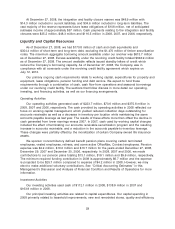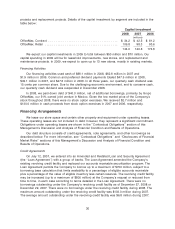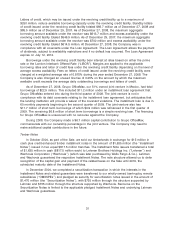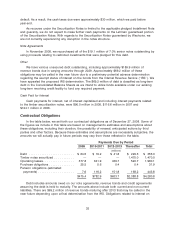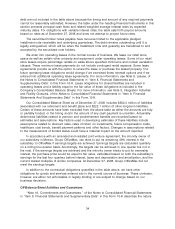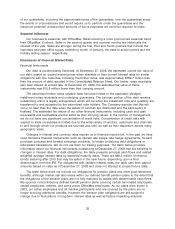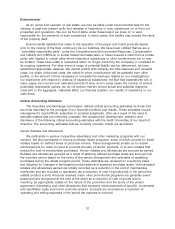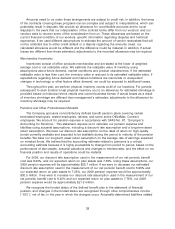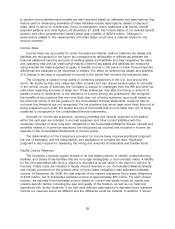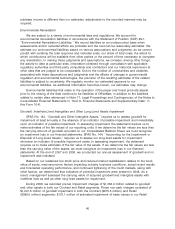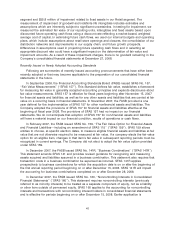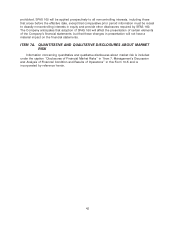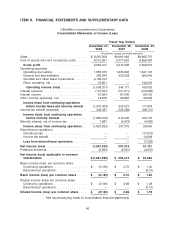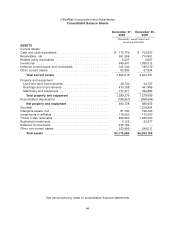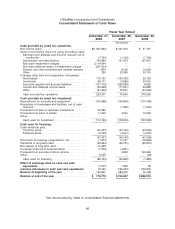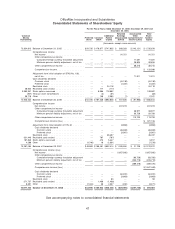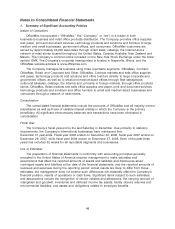OfficeMax 2008 Annual Report Download - page 42
Download and view the complete annual report
Please find page 42 of the 2008 OfficeMax annual report below. You can navigate through the pages in the report by either clicking on the pages listed below, or by using the keyword search tool below to find specific information within the annual report.Amounts owed to us under these arrangements are subject to credit risk. In addition, the terms
of the contracts covering these programs can be complex and subject to interpretations, which can
potentially result in disputes. We provide an allowance for uncollectible accounts and to cover
disputes in the event that our interpretation of the contract terms differ from our vendors’ and our
vendors seek to recover some of the consideration from us. These allowances are based on the
current financial condition of our vendors, specific information regarding disputes and historical
experience. If we used different assumptions to estimate the amount of vendor receivables that will
not be collected due to either credit default or a dispute regarding the amounts owed, our
calculated allowance would be different and the difference could be material. In addition, if actual
losses are different than those estimated, adjustments to the recorded allowance may be required.
Merchandise Inventories
Inventories consist of office products merchandise and are stated at the lower of weighted
average cost or net realizable value. We estimate the realizable value of inventory using
assumptions about future demand, market conditions and product obsolescence. If the estimated
realizable value is less than cost, the inventory value is reduced to its estimated realizable value. If
expectations regarding future demand and market conditions are inaccurate or unexpected
changes in technology or other factors affect demand, we could be exposed to additional losses.
Throughout the year, we perform physical inventory counts at all of our locations. For periods
subsequent to each location’s last physical inventory count, an allowance for estimated shrinkage is
provided based on historical shrink results and current business trends. If actual losses as a result
of inventory shrinkage are different than management’s estimates, adjustments to the allowance for
inventory shrinkage may be required.
Pensions and Other Postretirement Benefits
The Company sponsors noncontributory defined benefit pension plans covering certain
terminated employees, vested employees, retirees, and some active OfficeMax, Contract
employees. We account for pension expense in accordance with SFAS No. 87, ‘‘Employer’s
Accounting for Pensions.’’ This statement requires us to calculate our pension expense and
liabilities using actuarial assumptions, including a discount rate assumption and a long-term asset
return assumption. We base our discount rate assumption on the rates of return on high-quality
bonds currently available and expected to be available during the period to maturity of the pension
benefits. We base our long-term asset return assumption on the average rate of earnings expected
on invested funds. We believe that the accounting estimate related to pensions is a critical
accounting estimate because it is highly susceptible to change from period to period, based on the
performance of plan assets, actuarial valuations and changes in interest rates, and the effect on our
financial position and results of operations could be material.
For 2009, our discount rate assumption used in the measurement of our net periodic benefit
cost was 6.20%, and our expected return on plan assets was 7.50%. Using these assumptions, our
2009 pension expense will be approximately $25.7 million. If we were to decrease our estimated
discount rate assumption used in the measurement of our net periodic benefit cost to 5.95% and
our expected return on plan assets to 7.25%, our 2009 pension expense would be approximately
$30.0 million. If we were to increase our discount rate assumption used in the measurement of our
net periodic benefit cost to 6.45% and our expected return on plan assets to 7.75%, our 2009
pension expense would be approximately $21.5 million.
We recognize the funded status of the defined benefit plan in the statement of financial
position, and changes in the funded status are recognized through other comprehensive income
(‘‘OCI’’), net of tax, in the year in which the changes occur. Actuarially-determined liabilities related
38



